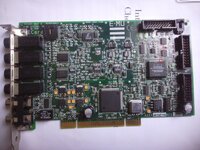kraka
Junior Member level 3

I have not electronics background but after two technicians refuse to repair my Audio Card, (maybe they did not have time, or they underestimate my card, althouth it is an excellent one), i decided to try, at least, fix it.
My Audio Card (PCI type) stopped having sound. After a closer inspection with a known technique (because i do not own a thermocamera) i saw that after injected 5 or more volts to pin no57 of side A of the Card, which has a label : AD(02) and a description : "I/O signal (May be driven by initiator or target, depending on operation)", and maybe means Address or Data bus ?, two components that are located very close to each other,
1)the ALTERA EPM 7064S1C44-10 BFB249919 EMU98 9946 and
2) : the P98AB VT244 , are getting hot very quickly.
They are getting hot even if the Card snap onto the motherboard, and Windows boots up.
P98AB VT244 is a component with 10 legs on the right and 10 on the left side. I do not know what is this, but i read somewhere that it is a Line Driver (what is this ?) or Amplifier. I search on web for a replacement but find nothing except this : 74LVT244 and SN54LVT244. I do not know at all, if i can replace P98AB VT244 with 74LVT244 or SN54LVT244.
The bad think is that i learned that the ALTERA is a programmable IC, and that i cannot just replace it with a new one. I must first program it with the "program" that is now inside the ALTERA on my Card, but i do not have this "program" (even if i had it, i do not know how to do it).
So my hope is the initial component that cause heat rising on the ALTERA to be the P98AB VT244. So if i replace it (the P98AB VT244) with a new one, both stop warming up and problem will be fixed.
But how to know which of those two is broken ? How to diagnose ?
I am attaching a picture of my card (Side B). I have drawn two red arrows, one bigger than the other. The big one points to the ALTERA EPM 7064S1C44-10 BFB249919 EMU98 9946 and the small one to the P98AB VT244.
Any other suggestion or idea, on how to try to make it have sound, are welcome.
Card is detected by Windows in "device manager", but cannot install any driver. I tried tones of drivers and all the OS's, from its native Win95-98 to Win7.
Before the problem occurred, it was installed in my WinXP PC with no problem. I am not sure 100% but maybe problem related with a faulty PSU that i have bougth at this time (have replaced later).
My Audio Card (PCI type) stopped having sound. After a closer inspection with a known technique (because i do not own a thermocamera) i saw that after injected 5 or more volts to pin no57 of side A of the Card, which has a label : AD(02) and a description : "I/O signal (May be driven by initiator or target, depending on operation)", and maybe means Address or Data bus ?, two components that are located very close to each other,
1)the ALTERA EPM 7064S1C44-10 BFB249919 EMU98 9946 and
2) : the P98AB VT244 , are getting hot very quickly.
They are getting hot even if the Card snap onto the motherboard, and Windows boots up.
P98AB VT244 is a component with 10 legs on the right and 10 on the left side. I do not know what is this, but i read somewhere that it is a Line Driver (what is this ?) or Amplifier. I search on web for a replacement but find nothing except this : 74LVT244 and SN54LVT244. I do not know at all, if i can replace P98AB VT244 with 74LVT244 or SN54LVT244.
The bad think is that i learned that the ALTERA is a programmable IC, and that i cannot just replace it with a new one. I must first program it with the "program" that is now inside the ALTERA on my Card, but i do not have this "program" (even if i had it, i do not know how to do it).
So my hope is the initial component that cause heat rising on the ALTERA to be the P98AB VT244. So if i replace it (the P98AB VT244) with a new one, both stop warming up and problem will be fixed.
But how to know which of those two is broken ? How to diagnose ?
I am attaching a picture of my card (Side B). I have drawn two red arrows, one bigger than the other. The big one points to the ALTERA EPM 7064S1C44-10 BFB249919 EMU98 9946 and the small one to the P98AB VT244.
Any other suggestion or idea, on how to try to make it have sound, are welcome.
Card is detected by Windows in "device manager", but cannot install any driver. I tried tones of drivers and all the OS's, from its native Win95-98 to Win7.
Before the problem occurred, it was installed in my WinXP PC with no problem. I am not sure 100% but maybe problem related with a faulty PSU that i have bougth at this time (have replaced later).


